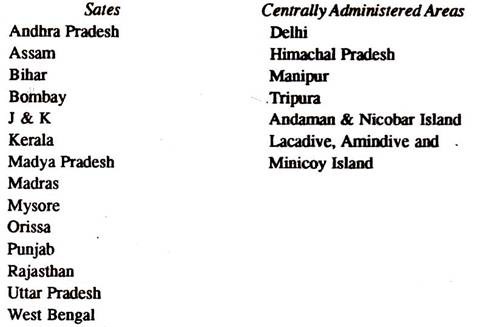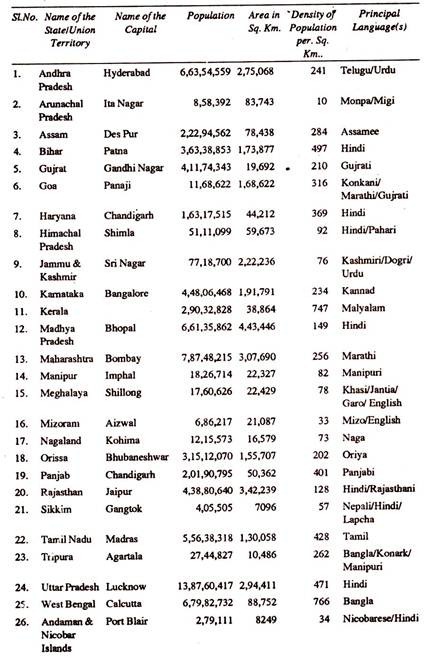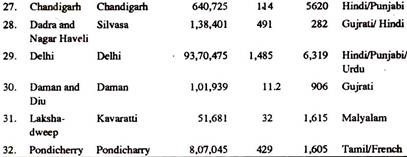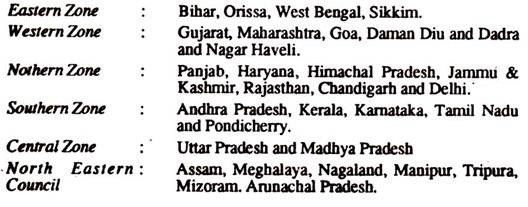In this essay we will discuss about “India – A Union of Statesâ€. After reading this essay you will learn about:- 1. Evolution of Indian States 2. Reorganisation of States 3. Reorganisation of States and After 4. India – A Union of States.
List of Essays on “India – A Union of Statesâ€
Essay Contents:
- Essay on the Evolution of Indian States
- Essay on the Reorganisation of States
- Essay on the Reorganisation of States and After
- Essay on India – A Union of States
1. Essay on the Evolution of Indian States:
According to Article I of the Constitution, India, i.e., Bharat shall be a Union of States, which shall consist of Indian states and a powerful central government at the helm. The states shall have their own constitutional obligations to discharge and under the constitution these have much less powers, as compared with the Centre.
India being a Union of States no agreement was signed between the central government and the federating states, for the creation of federation. Constitution makers themselves decided about the powers to be given to the States and those which should be kept in the Central and in the Concurrent list.
Indian states have their own history. Before independence the whole of India was divided into Indian provinces, where national movement was quite wide spread than what it was in Indian princely states. Each state, big or small, was governed by a feudal prince, who was autocrat and it all depended on him to which extent he cared for the sentiments of the people. Some of these states were big while others were small.
After independence Sardar Vallabh Bhai Patel persuaded these about 600 princely states to become an integral part of newly born free India. Except Hyderabad, where police action had to be taken and Junagarh where a referendum was held before it joined Indian federation, every other state agreed to this. Subsequently whole of India was temporarily divided into four types of States.
Part ‘A’ States consisted of British Indian provinces. Some of the States which were quite big and administratively viable were allowed to retain their identity, whereas in some cases two or more adjoining states were combined together to form one administrative unit.
These were called Part ‘B’ States. Then there were some states which centre decided to administer itself, because it was not possible to either merge these with any province or with any group of states or otherwise it was expedient to keep these under central control. These states were called part ‘C’ States. Andaman Nicobar Islands were placed under the category of part ‘D’ State.
In fact, the whole process of integration was very quick and a very remarkable one. Perhaps there is 110 other parallel in the history of world where princes in such a large number, occupying such vast territories and enjoying autonomy and powers voluntarily agreed to given up their sovereign rights.
Credit undoubtedly goes to the iron man of India, Sardar Vallabh Bhai Patel, who did the marvellous job of bringing Indian States in the folds of free India.
According to the arrangement which was thus made Assam, Bengal. Bihar, Orissa, Punjab, Madras, etc., were designated part ‘A’ states, whereas Hyderabad, J & K, PEPSU (Patiala and East Punjab States Union), Rajasthan. Travancore and Cochin states were placed under the category of part ‘B’ states. In part ‘C’ were placed Ajmer, Manipur, Tripura, Delhi, Coorg, etc. and Andaman and Nicobar Islands were placed under part ‘D’ category.
But by no means this could be a lasting arrangement because the Britishers during their stay in India, never created a province taking into consideration cultural and lingual homogeneity.
All they cared was administrative convenience. In addition to this princely states had been merged in Indian provinces or grouped together only as a matter of temporary convenience and to speed up the process of integration. Therefore, there was great need that this adhoc arrangement should be rationalised as quickly as possible.
2. Essay on the Reorganisation of States:
Indian National Congress during freedom struggle had repeatedly made a promise to the people of India that after independence the states will be reorganised on the basis of cultural and lingual homogeneity of the areas.
Accordingly S.K. Das Commission was appointed by the Government of India to make recommendations about the reorganisation of the states. The Commission which submitted its report in December, 1948 was of the view that the major consideration for the reorganisation of states should be administrative convenience and not the language of the people or their culture or traditions.
This created much resentment and the proposal was also disapproved by the Indian National Congress. At its session held at Jaipur, the Congress set up another Committee consisting of Pt. Jawahar Lal Nehru, Sardar Vellabh Bhai Patel and Pattabhai Sitaramayya to examine the whole question afresh.
This Committee also felt that it was better to reorganise the states on the basis of administrative convenience, but since there was great demand and public sentiments had sufficiently arisen, therefore, these might be reorganised on lingual basis.
But the authors of the report were of the view that it was not appropriate time for the reorganisation of states, because the conditions in the country were very instable and any reorganisation was not only likely to result in dislocation, but also in administrative, financial and other strains. In the opinion of the Committee any organisation at this stage was likely to result more in disorganisation rather than in organisation.
The Committee, however, felt that there was a case for the creation of Andhra State. This provided an opportunity to Telugu speaking people to press their demand for the creation of this state. As anticipated by the Committee there were violent demonstrations and some clashes in which few lost their lives.
P. Sriramulu went on hunger strike unto death and lost his life. The result of all this was that the government was forced to create a new state of Andhra Pradesh in 1953.
Once it was accepted that language was the basis for the creation of states then many other agitations and chain reactions started. There were violent and unhappy incidents in some parts of the country. This forced the government to announce on 22 December, 1955 that it proposed to set up a Commission to examine the whole question of reorganisation of states.
Accordingly a Commission was constituted under Fazl Ah. Its other two members were Sardar K.M. Panikkar and Pt. H.N. Kunzru. The Commission submitted its report on 30th September, 1955. It was of the view that A, B,. C and D states which were hitherto existing should be abolished and instead new states should be created. In its view, in India there should be states and centrally administered areas.
The Commission also suggested that there should be 16 states and 3 centrally administered areas. The government, however, modified the recommendation and agreed that there should be only 14 states and 5 centrally administered areas. The government did not accept the need for the creation of a state each of Vidarbha and Hyderabad. It was felt by it that Himachal Pradesh and Tripura should only be centrally administered areas.
As a result of the recommendations of State Reorganisation Commission and as modified by the Government of India, the following states were created:
3. Essay on the Reorganisation of States and After:
But this was not the end of it As soon as new states came into being again there were violent demonstrations by those who were not satisfied with the arrangement The Gujarati and the Marathi speaking people wanted to have separate states, but they did not get that. Similarly the hill people, the Nagas and Sikhs all wanted to have separate states, where they could develop their own language.
Since the States Reorganisation Act did not satisfy them, therefore, the people there started agitations. Meanwhile the Government of India was pressing foreign powers, which had their pockets in India to quit the country so that these territories also could become an integral part of India.
Whereas one such power namely, France, agreed to withdraw and signed necessary agreement with the Government of India, the other power, Portugal, did not agree and all persuations in this regard failed.
On the other hand, Portguese authorities in India ruthlessly crushed every agitation which freedom fighters in Goa, Daman and Diu started. Ultimately the Government of India had no other alternative but to take police action against Portugal authorities in India and Goa, Daman and Diu became a part of India.
For quite some time the Government of India checked every temptation to form any new state or reorganise any existing one but it became difficult to check due to ever-increasing mounting pressure from the people. In 1956, France signed an agreement with India and Pondicherry became a part of the country.
It was made a union territory. Other territories, namely, Mahe, Karikal and Yaman, which India got from France, were merged with adjoining states. In this way a new union territory was born.
In 1961, Portugal was made to leave India and with that Goa, Daman and Diu became parts of Indian Union. The territories thus acquired were also made a Union Territory. But there was great pressure both from Gujarati and Marathi speaking people that Bombay state should be bifurcated so that each part could develop its own language in the way it liked.
In 1960, the Government of India agreed to this and Bombay was divided into two states of Gujarat and Maharashtra.
The process continued. The Sikhs in Punjab, under the leadership of Master Tara Singh demanded a home-land for themselves and the people of Haryana region were not lagging behind in pressing their demand for a separate state of Haryana.
As a result of this in 1966 the then existing state of Punjab was divided into Punjab and Haryana and in this way after the bifurcation of Bombay, Punjab had to be bifurcated. Both the states of Punjab and Haryana, however, wanted Chandigarh for themselves.
Again there were agitations and when the situation became difficult to control, the government decided to make it a Union Territory. Subsequently the government decided to make Chandigarh a part of Punjab, provided the latter was ready to part with few areas of Ferozepur.
But since Punjab was not willing for this the result was that Chandigarh could not be transferred to it. Subsequent efforts made to solve Chandigarh issue under Rajiv-Longowal Accord also proved a failure and so far Chandigarh remains a Union Territory.
Eastern side of India was equally not quiet. The people of Nagaland w ere demanding a separate state of Nagaland. Some of the Naga leaders even went underground and claimed that Nagaland was not a part of India. In order to satisfy the Nagas a separate state of Nagaland was created in 1963.
In 1969, autonomous state of Meghalaya, which was subsequently made a full-fledged state out of the State of Assam was created. In 1975, Sikkim became a full-fledged state but in between in 1971, Himachal Pradesh was given the status of a full-fledged state and so was the case with the Union Territories of Tripura and Manipur.
In 1974, Sikkim was given the status of an Associate State, but subsequently it was given the status of full-fledged state. In 1987, as a result of government’s agreement with Mizo National Front concluded in 1986, Mizoram which was hitherto a Union Territory was given the status of a full-fledged state. In February, 1987, state of Arunachal Pardesh was inaugurated.
Present position in respect of Indian States and Union Territories which form part of Indian federation is as under. (As per 1991 Census):
4. Essay on India – A Union of States:
Constitution fathers could have specifically mentioned that India shall be a union of states, instead of saying that the country shall be a federation as was the case with the USA and Canada. While replying to this point the chairman of the Drafting Committee Dr. B.R. Ambedkar said, “But I can tell you that why drafting committee wanted to make it clear that though India was to be a federation, the federation was not the result of an agreement by the states to join in a federation and that the federation not being the result of an agreement no state has the right to secede from it….The Drafting Committee thought that it was better to make it clear at the very outset rather than to leave it to speculation.”
Since none of the states was independent and sovereign in the sense in which American colonies or Swiss Cantons were, therefore, the Centre was given full-fledged right to change the boundaries of any states, in the manner and at a time it liked.
In the words of Shukla, “The Constituent Assembly of India, deriving its power from the sovereign people, was unfettered by any commitment to evolve a constitutional pattern suitable to the genius and requirements of the Indian people as a whole.”
India can acquire any new territory and such a territory is supposed to have been acquired when Indian Union establishes its sovereignty over it. It is no body’s concern technically to know how a territory has been acquired but in actual practice pressure of international organisations is so heavy that it is difficult to acquire and retain a territory, which has not the approval of international community.
Since the Parliament is sovereign body, therefore, change of boundary of a state cannot be called cession of territory.
It is left to the Parliament to decide on what terms and conditions a new state should be admitted to the Indian union and as such a newly admitted state cannot claim status of equality with the already existing states, as against the USA where the states have equality of status and even new states too can claim equality.
Founding fathers of the constitution also did not use the word federation and preferred to call it a union of states be9ause they wanted to have a very strong Centre which could preserve integrity and stability of the country. In addition, they were also guided by the consideration that India which was going to be welfare state would have very vast and wide responsibilities.
A powerful and strong government which was fully well equipped with sufficient resources and authority alone could deal with such problems with considerable speed. Not only in the national field, but the constitution makers also realised, that India was going to have very huge responsibilities in international field as well.
A weak and divided India under the constant threat of cession from the states could not play its role in a very dignified manner. It was, therefore, thought very appropriate that federating units of the federation should not be given a sense by which these felt that these were part of a federation on the basis of equality, but that they were just a member of union of states.
According to the Constitution of India Parliament is the sole authority to admit into the Union or establish a new state on such terms and conditions which it might deem fit It can form a new state, increase the area of any state as well as reduce that. It can also change the name of new state and for that matter even that of a city. The centrally administered territories are under the direct control of the centre.
The Parliament can change political map of India by means of a unilateral action and has absolute authority by creating a new state by mere reference by the President of India to the concerned state.
A law made by the Parliament in this regard is not to be regarded as an amendment of the Constitution and no such reference about the change of area of a state, etc., by the President to the state concerned is needed in the case of Union Territory. Art 255 of Constitution provides that judiciary will not invalidate such law on the grounds that its introduction was not recommended by the President.
The Parliament is the sole authority to decide about the time and the manner of admission of new territory in the union with or without conditions. Sikkim was first admitted as Associate State’ and Meghalaya as ‘Autonomous State’ before these were given the status of a full-fledged state.
Zonal Councils:
India being a very vast country, need and necessity of co-operation and co-ordination at state level has all along been felt. Accordingly as early as in 1956 need and necessity of an organisation which could provide a forum where states could meet and make recommendations as advisory bodies, was felt Accordingly Zonal Councils were created, but with the passage of time arrangements made under States Reorganisation Act, 1956 had to be disturbed, by creating either new states or Union Territories and so on and so forth.
Now the whole of India is divided into 6 Zones and the states covered under each Zone are as under:
Each zonal Council is to be presided over by the Home Minister or by any other Minister of the Union Government, who may be nominated by the President. Vice-Chairmanship is, however, rotated among the Chief Ministers of the States included in the Council. It also includes Chief Ministers of the States concerned and two other Ministers, who may be nominated by the Governors of the States concerned.
It is provided that the President will nominate a member in the case of a Union Territory, if that is a member of the Council. Some civil servants are also members of each Council, e.g., the Chief Secretaries of the States included in the Council and their Development Commissioners. The decisions in the Council are taken by majority of votes in which officials are not allowed to vote.
These Councils are expected to perform only advisory functions and work in a manner that there is emotional integration. The Councils are also expected to help in checking evils of lingualism, regionalism and casteism and help the central government in evolving uniform social and economic policies.
India is developing through plans and as such it is the duty of these Councils to see that there is proper execution of plan projects without waste of time money and resources. It is the responsibility of each Zonal Council to promote emotional integration and also to help in the exchange of ideas and evolving of uniform policies. It should also try to secure some kind of political equilibrium between different regions and zones.
Though in the arrangement of things in India Zonal Councils were required to play a very important role, yet in practice these have not come up to the expectations of the people. Of course, in some cases these have helped in settling inter-state disputes, yet on the whole more is expected from them.
The concept of ‘Union of States’ rather than that of a ‘federation’ has served its purpose. It has enabled the central government to conveniently change the boundaries of the states, as these suited to national needs.
Had there been a ‘federation’ in classical sense of the term, central government would not have kept pace with the needs of the hour and most of states would have taken strong postures and resisted every attempt to change state boundaries, in case these did not suit their convenience.
In India there has been consistent and persistent demand from various sections of society for the earring out of new states out of the existing states. For this the agitators organise demonstrations, agitations and try to motivate the people by several ways. At times there are also violent incidents resulting in loss of life and property. At present there is forceful demand for the creation of a hill state in U.P. comprising of hill areas of that state.
But the Government of India does not seem to be favourably inclined to the creation of small states. In order to meet, however, the aspirations of the people Autonomous Councils are created within the state itself. Each such Council consists of some elected and some nominated representatives, the former having a majority. The Council is given sufficient autonomy in dealing with subjects which are allotted to it in the agreement. Darjeeling Hill Council, Leh Council are some of the examples to quote. Creation of a Council at least partly satisfies the agitators.



